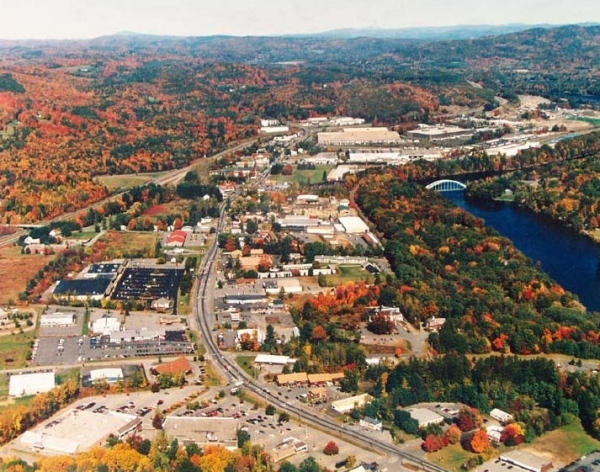BRATTLEBORO — Fourteen years after the plan was approved by the Selectboard, the Vermont Agency of Transportation says it can see “the light at the end of the tunnel” for the multi-year Putney Road project.
It's an undertaking that state Roadway Design Project Manager Ken Upmal calls “this long, drawn-out, legacy project.”
“Yes, the project's been around forever, but it's gone through a number of iterative processes that I don't want to bore you with,” said Upmal Tuesday when asked for an update. “I think people have grown impatient with the advancement of the project, but the nature of it is daunting.”
“Basically, we have done a very admirable job over the last four years getting the project from the post-conceptual stage to where we are today, which is completing right-of-way plans in the next 60 days,” he continued.
“It really is an incredible undertaking, and now we are fully into the last process before contract and construction,” Upmal said. “We can see the light at the end of the tunnel for this long, drawn-out, legacy project.”
The plan
Overall, the project stretches 1.23 miles along Putney Road from the Veterans' Memorial Bridge to the Exit 3 roundabout.
The now-estimated $30 million project - to be paid for with 80 percent federal money and 20 percent state money - involves removing four “signalized” intersections, each with more than one traffic beacon.
Four new roundabouts, or traffic circles, will be added: at Royal Square Plaza (Staples and Aldi), Technology Drive, Hannaford Plaza, and Black Mountain Road.
The roadway will be a single lane or hybrid versions of single-lane highways. A median will run along the middle of the road, forcing drivers to use the roundabouts rather than cross traffic.
“This project will be unprecedented in nature because it will create a 1.2-mile section of highway in the state comprised of five continuous roundabouts,” Upmal says.
The project is part of the scoping study of the Brattleboro Master Plan.
“It's all about connectivity,” Upmal says. “It's extremely difficult and dangerous to drive on this road, never mind cross it. This project is going to address all of this.”
“From the get-go, the reason was all the rear-end and sideswipe collisions,” he continued. “When you separate and divide the highway, you eliminate that. And we're still improving the overall safety and mobility of the highway. We are significantly enhancing the corridor.”
While some residents have been wondering not only what's taking so long but also asking what about a decent bike path, Upmal says part of the final design will provide 12-foot-wide, shared-use paths throughout most of the corridor for pedestrians and bicyclists.
There is also a 5-foot-wide shoulder along the corridor where cyclists can ride.
“This is going to be an amazing corridor for not only pedestrians, but also bicyclists,” Upmal says, noting that at each roundabout there will also be signalized, flashing-beacon, pedestrian/bicyclist crossing devices.
Next steps
Completing right-of-way work includes several tasks.
First, plans are drafted and valuations established for easements on each parcel - there are 83, mostly commercial parcels affected - some of which will be, says Upmal, easier than others, which will be formal appraisals.
Next is the appraisal process, and finally, the negotiation process for settlement.
“The real challenges in a project like this are right-of-way - which is very sensitive - environmental permitting, and utility relocation, not engineering,” says Upmal, adding that valuations and negotiations will be running concurrently.
“We'll be continuing the right-of-way process for the next year and a half,” he says.
Once that part is completed, any abutters not reaching settlement with the state will cause the state to enter into “necessity condemnation,” formal court proceedings during which it will plead its case that the properties in question are needed “in the interest of the public good.”
That, Upmal said, can take 6 to 9 months. Once completed, the Agency will develop final contract plans - which can take 12 months - and then finally advertise and put the project out to bid.
Despite the already-beyond-lengthy wait for the project to start, Upmal, who has been in his job for 30 years and has an affable, “seen-it-all,” straight-shooting delivery, said actual construction is anticipated to start in 2026.
“Let me just give you a feel for this,” he said earnestly. “This project is now approaching reality. The design is done. I have 83 parcels, and we've met with 81 owners with buy-in from almost all of them.”
He described that task as “an extremely arduous process, not like building a bridge and talking to four abutters.”
“Appraisals take months to perform, and we have a whole bunch of them because of the commercial nature of the corridor,” he continued.
“These are all commercial properties, so this is all about money,” he said. “I would anticipate necessity proceedings, but we are absolutely approaching the final phases of the project.”
“People say, '2026?' but in my world, that's tomorrow. This is the reality of it. These are legacy projects; they've been around forever.”
